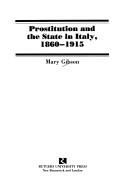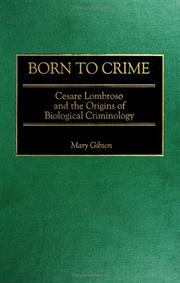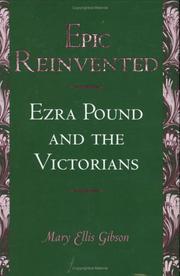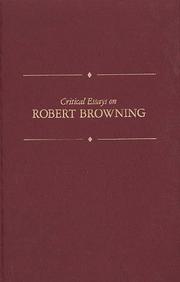| Listing 1 - 10 of 24 | << page >> |
Sort by
|
Book
ISBN: 9781350055322 1350055328 Year: 2019 Publisher: London : Bloomsbury,
Abstract | Keywords | Export | Availability | Bookmark
 Loading...
Loading...Choose an application
- Reference Manager
- EndNote
- RefWorks (Direct export to RefWorks)
During a period dominated by the biological determinism of Cesare Lombroso, Italy constructed a new prison system that sought to reconcile criminology with nation building and new definitions of citizenship. Italian Prisons in the Age of Positivism, 1861-1914 examines this "second wave" of global prison reform between Italian Unification and World War I, providing fascinating insights into the relationship between changing modes of punishment and the development of the modern Italian state. Mary Gibson focuses on the correlation between the birth of the prison and the establishment of a liberal government, showing how rehabilitation through work in humanitarian conditions played a key role in the development of a new secular national identity. She also highlights the importance of age and gender for constructing a nuanced chronology of the birth of the prison, demonstrating that whilst imprisonment emerged first as a punishment for women and children, they were often denied "negative" rights, such as equality in penal law and the right to a secular form of punishment. Employing a wealth of hitherto neglected primary sources, such as yearly prison statistics, this cutting-edge study also provides glimpses into the everyday life of inmates in both the new capital of Rome and the nation as a whole. Italian Prisons in the Age of Positivism, 1861-1914 is a vital study for understanding the birth of the prison in modern Italy and beyond.
Imprisonment --- Prisons --- History --- Italy --- Confinement --- Incarceration --- Corrections --- Detention of persons --- Punishment --- Prison-industrial complex --- Dungeons --- Gaols --- Penitentiaries --- Correctional institutions --- School-to-prison pipeline
Book
ISBN: 1350055352 9781350055353 9781350055339 1350055336 Year: 2019 Publisher: London ; New York : Bloomsbury Academic,
Abstract | Keywords | Export | Availability | Bookmark
 Loading...
Loading...Choose an application
- Reference Manager
- EndNote
- RefWorks (Direct export to RefWorks)
"During a period dominated by the biological determinism of Cesare Lombroso, Italy constructed a new prison system that sought to reconcile criminology with nation building and new definitions of citizenship. Italian Prisons in the Age of Positivism, 1861-1914 examines this "second wave" of global prison reform between Italian Unification and World War I, providing fascinating insights into the relationship between changing modes of punishment and the development of the modern Italian state. Mary Gibson focuses on the correlation between the birth of the prison and the establishment of a liberal government, showing how rehabilitation through work in humanitarian conditions played a key role in the development of a new secular national identity. She also highlights the importance of age and gender for constructing a nuanced chronology of the birth of the prison, demonstrating that whilst imprisonment emerged first as a punishment for women and children, they were often denied "negative" rights, such as equality in penal law and the right to a secular form of punishment. Employing a wealth of hitherto neglected primary sources, such as yearly prison statistics, this cutting-edge study also provides glimpses into the everyday life of inmates in both the new capital of Rome and the nation as a whole. Italian Prisons in the Age of Positivism, 1861-1914 is a vital study for understanding the birth of the prison in modern Italy and beyond."--Bloomsbury Publishing.
Prisons --- Prison discipline --- Positivism. --- History --- Law and legislation

ISBN: 0813511720 Year: 1986 Publisher: New Brunswick (N.J.) : Rutgers university press,
Abstract | Keywords | Export | Availability | Bookmark
 Loading...
Loading...Choose an application
- Reference Manager
- EndNote
- RefWorks (Direct export to RefWorks)
Prostitution --- History

ISBN: 0275970620 Year: 2002 Publisher: New York (N.Y.) : Praeger,
Abstract | Keywords | Export | Availability | Bookmark
 Loading...
Loading...Choose an application
- Reference Manager
- EndNote
- RefWorks (Direct export to RefWorks)
Criminal anthropology. --- Criminal behavior --- Genetic aspects.
Book
ISBN: 0906891000 Year: 1979 Publisher: Yeovilton : Fleet Air Arm Museum for the Society of Friends of the Fleet Air Arm Museum,
Abstract | Keywords | Export | Availability | Bookmark
 Loading...
Loading...Choose an application
- Reference Manager
- EndNote
- RefWorks (Direct export to RefWorks)
Air pilots, Military --- World War, 1914-1918 --- Biography --- Aerial operations, British. --- Warneford, Reginald Alexander John,

ISBN: 9780275970628 9780313086298 Year: 2002 Publisher: Westport Praeger
Abstract | Keywords | Export | Availability | Bookmark
 Loading...
Loading...Choose an application
- Reference Manager
- EndNote
- RefWorks (Direct export to RefWorks)
Despite the popular perception that genetic explanations of the causes of crime are new, biological determinism dates back to the birth of criminology, and the ideas of the man widely regarded as its founder, Cesare Lombroso. His 1876 work, Criminal Man, drew on Darwin to propose that most lawbreakers were throwbacks to a more primitive level of human evolution―identifiable by their physical traits, such as small heads, flat noses, large ears, and the like. These born criminals could not escape their biological destiny.The scientific appeal of these theories of criminal anthropology had a powerful and long-lasting impact on criminological theory and practice in contemporary Italy, Europe, and the Western world as a whole, and even today the stereotypes they created resonate in popular culture. But while these ideas had a wide influence, their origins were very much in a specific time and place―the political, economic, and social history of modern Italy. Gibson shows that understanding the development of Lombroso's thinking is much more complicated than merely pinning his ideas onto the left-right political spectrum; he influenced socialists and fascists, lawyers and doctors, policemen and social workers alike. In the end, she argues for a more subtle interpretation of his theories, emphasizing that Lombroso himself acknowledged the multifaceted nature of criminal behavior.
Criminal behavior --- Criminal anthropology --- Genetic aspects --- Lombroso, Cesare,

ISBN: 0801431336 9780801431333 Year: 1995 Publisher: Ithaca, N.Y. Cornell University Press
Abstract | Keywords | Export | Availability | Bookmark
 Loading...
Loading...Choose an application
- Reference Manager
- EndNote
- RefWorks (Direct export to RefWorks)
Pound, Ezra --- English literature --- Epic poetry, American --- Modernism (Literature) --- Politics and literature --- History and criticism. --- English influences. --- History --- Literature --- Literature and politics --- American epic poetry --- American poetry --- History and criticism --- English influences --- Political aspects --- Pound, Ezra, --- Pound, Ezra Loomis, --- Atheling, William, --- Bawnd, Izrā, --- Paount, Ezra, --- Pʻaundŭ, Ejŭra, --- Pavnd, Ezra, --- E. P. --- P., E. --- T. J. V., --- V., T. J., --- Pangde, --- Poet of Titchfield Street, --- Knowledge --- Literature. --- Political and social views.

ISBN: 0816188610 Year: 1992 Publisher: New York (N.Y.): Hall
Abstract | Keywords | Export | Availability | Bookmark
 Loading...
Loading...Choose an application
- Reference Manager
- EndNote
- RefWorks (Direct export to RefWorks)
Browning, Robert, --- Criticism and interpretation --- Critique et interprétation --- Browning, Robert --- -ロバート・ブラウニング --- -Criticism and interpretation --- Critique et interprétation --- Brauning, Robert, --- Bŭrauning, --- Criticism and interpretation.
Book
ISBN: 0821443577 9780821443576 9780821419427 0821419420 9780821420782 082142078X Year: 2011 Publisher: Athens Ohio University Press
Abstract | Keywords | Export | Availability | Bookmark
 Loading...
Loading...Choose an application
- Reference Manager
- EndNote
- RefWorks (Direct export to RefWorks)
Anglophone Poetry in Colonial India, 1780-1913: A Critical Anthology makes accessible for the first time the entire range of poems written in English on the subcontinent from their beginnings in 1780 to the watershed moment in 1913 when Rabindranath Tagore won the Nobel Prize in Literature.Mary Ellis Gibson establishes accurate texts for such well-known poets as Toru Dutt and the early nineteenth-century poet Kasiprasad Ghosh. The anthology brings together poets who were in fact colleagues, competitors, and influences on each other. The historical scope of the anthology, beginning with the fa
Indic poetry (English) --- English poetry --- Indic literature (English) --- History and criticism. --- India
Book
ISBN: 9780821419410 9780821443583 0821443585 0821419412 0821425218 Year: 2011 Publisher: Athens Ohio University Press
Abstract | Keywords | Export | Availability | Bookmark
 Loading...
Loading...Choose an application
- Reference Manager
- EndNote
- RefWorks (Direct export to RefWorks)
In Indian Angles, Mary Ellis Gibson provides a new historical approach to Indian English literature. Gibson shows that poetry, not fiction, was the dominant literary genre of Indian writing in English until 1860 and that poetry written in colonial situations can tell us as much or even more about figuration, multilingual literacies, and histories of nationalism than novels can. Gibson recreates the historical webs of affiliation and resistance that were experienced by writers in colonial India-writers of British, Indian, and mixed ethnicities. Advancing new theoretical and historical paradig
Colonies in literature. --- Indic poetry (English) --- Anglo-Indian poetry --- English poetry --- Anglo-Indian literature --- History and criticism. --- India --- In literature.
| Listing 1 - 10 of 24 | << page >> |
Sort by
|

 Search
Search Feedback
Feedback About UniCat
About UniCat  Help
Help News
News